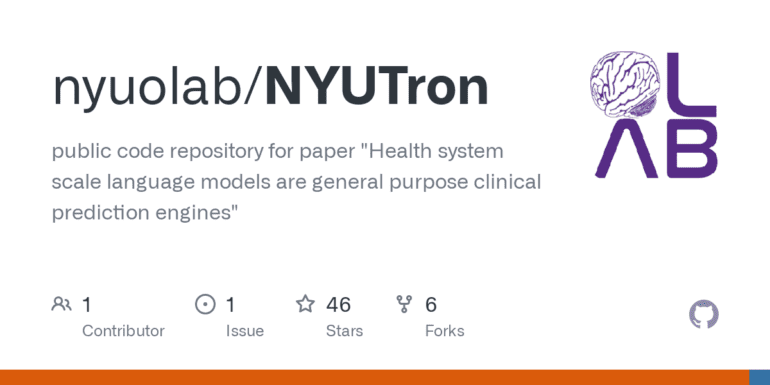TL;DR:
- NYU Langone Health introduces NYUTron, an AI-powered tool for hospital operations and patient care.
- NYUTron is a Large Language Model (LLM) that accurately predicts hospital readmission and other health outcomes.
- Traditional computer algorithms struggle with unstructured data, but NYUTron learns from the unaltered text in electronic health records.
- A recent study shows NYUTron predicts 80% of readmissions, outperforming non-LLM models.
- NYUTron alerts healthcare providers about factors that may lead to readmission, enhancing patient care and workflow efficiency.
- Large language models like NYUTron have the potential to revolutionize healthcare and create “smart hospitals.”
- NYUTron’s success opens up possibilities for extracting billing codes, predicting infection risks, and aiding in medication selection.
- NYUTron is designed to support healthcare providers and complement their expertise, not replace them.
Main AI News:
In a groundbreaking development, NYU Langone Health has introduced NYUTron, an innovative artificial intelligence (AI) tool that is set to transform hospital operations and enhance patient care. This cutting-edge system, featured in the recent article “New ‘AI Doctor’ Predicts Hospital Readmission and Other Health Outcomes,” leverages the power of a Large Language Model (LLM) to deliver accurate predictions and assessments for healthcare providers.
Traditional attempts to harness the potential of computer algorithms in healthcare have often fallen short due to the disparity between structured data and the nuanced language used by physicians. However, NYUTron overcomes this hurdle by utilizing large language models capable of comprehending unaltered text from electronic health records. The remarkable advantage of this approach is that it eliminates the need for cumbersome data reorganization and allows the AI system to “learn” directly from physicians’ notes.
A recent study, published in the prestigious journal Nature, showcased the remarkable capabilities of NYUTron. By training the LLM using millions of clinical notes from the NYU Langone hospital system, the researchers created a formidable tool capable of accurately predicting various critical factors, including the likelihood of patient readmission. Impressively, NYUTron outperformed traditional computer models by achieving an 80% success rate in identifying readmission cases—a notable 5% improvement.
Lead author Lavender Jiang, BSc, emphasized the potential of large language models like NYUTron to revolutionize patient care. By swiftly alerting healthcare providers to factors that may lead to a readmission or other concerns, the technology enables timely interventions and enhances overall patient outcomes. Moreover, the automation of basic tasks through AI can streamline workflows, allowing physicians to devote more time to direct patient interaction—a pivotal element of quality healthcare.
The underlying mechanism driving large language models lies in their ability to predict the most appropriate words to complete a sentence, based on real-world language patterns. As NYUTron’s training dataset expanded to encompass 4.1 billion words from clinical records, its accuracy and predictive power improved significantly.
The remarkable performance of NYUTron further underscores its potential to advance the concept of “smart hospitals.” By seamlessly integrating with existing electronic health records, the AI system facilitates rapid implementation throughout the healthcare system. This transformative tool, developed by NYU Grossman School of Medicine, represents a tangible step toward personalized healthcare and optimized decision-making.
Dr. Eric Oermann, a renowned neurosurgeon and senior author of the study, envisions a future where NYUTron expands its capabilities beyond readmission prediction. Possibilities include extracting billing codes, identifying infection risks, and even aiding in medication selection. However, Oermann emphasizes that NYUTron is designed to augment healthcare providers’ expertise, not replace it. The system acts as a support tool, empowering physicians with valuable insights tailored to individual patients.
The study received critical support from the National Institutes of Health (NIH) through grants P30CA016087 and R01CA226527. Additional funding was provided by the W.M. Keck Foundation Medical Research Grant, highlighting the importance of collaboration between research institutions and philanthropic organizations.
Dr. Oermann’s involvement with Sofinnova Partners and Artisight Inc., along with his spouse’s employment at Mirati Therapeutics, exemplifies the strong ties between academia and industry. NYU Langone Health manages these relationships diligently, adhering to policies and practices that prioritize ethical conduct and transparency.
Conclusion:
The introduction of NYUTron by NYU Langone Health represents a significant breakthrough in healthcare. By harnessing the power of AI and large language models, NYUTron provides accurate predictions and assessments that enhance patient care and improve workflow efficiency. This technology has the potential to revolutionize the healthcare market by enabling the development of “smart hospitals” and facilitating data-driven decision-making. As AI continues to advance, the integration of such tools will shape the future of healthcare delivery, benefiting both providers and patients.

